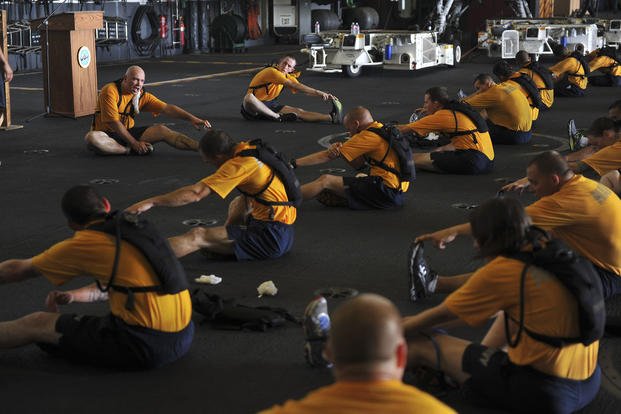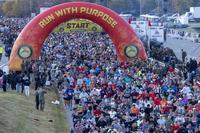The most common fitness test used is one you can find in a majority of the military branches and most law enforcement departments. The standard physical fitness test (PFT) consists of push-ups, sit-ups, sit and reach, and a 1.5-mile run.
Here are just a few of the groups who use this test as not only an entrance test to be hired but also a maintenance test performed every six months in order to remain employed:
Navy: Push-ups two minutes, sit-ups two minutes, 1.5-mile run
Air Force: Push-ups one minute, sit-ups one minute, 1.5-mile run
Army: Push-ups two minutes, sit-ups one minute , two-mile run (add half-miles = same way to train)
Coast Guard: Push-ups one minute, sit-ups one minute, 1.5-mile run
Many law enforcement agencies use this test as well for a fitness assessment entrance exam, including the Maryland State Police, Delaware, New Jersey, West Virginia, New York, Alaska, Iowa, North Dakota, Utah, New Mexico, Maine, Montana, Alabama and other federal, state and local police departments.
The PFT Bible: Physical Fitness Test Exercises (Tips and Sample Workouts)
Running -- 1.5-mile run
Repeat 6-8 times.
Run a quarter-mile at goal pace. That is, if your goal is to run 1.5 miles in 10 minutes, 30 seconds, then your quarter-mile time should be at 1:45 for each lap.
Rest with a 100-meter walk
Add in squats or lunges to build endurance in legs as well as jumping skills.
- Pace, breathing, arm swing, stride: Learn to regulate your breathing by timing inhales for 2-3 steps and exhales for 2-3 steps in a regular breathing rhythm to keep your heart rate lower and running faster in the last quarter-mile.
- Arm swing and stride: Your arms should be slightly bent but relaxed and swing in a straight line, not crossing your body. Your stride and foot strike should be efficient enough so you are not running on your toes or too long where you land on your heels. Your foot strike should be closer to the balls of the feet but not flat-footed.
- Injury prevention/stretch properly: Warm up well and stretch by jogging or doing jumping jacks and a few squats. Learn how to pace your 1.5-mile run by breaking the run down into quarter- and half-mile interval workouts like this.
Sit and Reach
Not many people fail this test. Basically, it is a toe-touch test. If you can sit on the floor with your knees straight in front of you and touch your toes, you pass. However, a few people do not pass this one. It requires incorporating a daily stretching routine into your life to help pass this test. A good stretching plan only takes 5-10 minutes and can be split up throughout the day. If your hamstrings and lower back are somewhat flexible, you can pass this test.
Push-ups
The push-up is the most commonly used exercise in military, law enforcement and firefighter training programs. Learning how to ace a fitness test is required for most groups, but doing multiple sets of countless push-ups usually is required in most indoctrination training programs (boot camps, basic training, military and law enforcement and firefighting academies).
Here are some tips:
- Proper hand placement: Keep your hands just greater than shoulder width apart and placed lower than your shoulders as if you were doing a bench press. This will place an equal amount of force on the chest, shoulders and triceps.
- Up/down movement: Push-ups in this test are a one- to two-minute sprint. Building your endurance to do nonstop push-ups for one minute is not as difficult as it may first appear. To score your best, you should focus on doing push-ups as fast as you can. However, exert on the up motion and relax your arms when coming down. Let gravity take you down.
These workouts are used to build a foundation for your push-up scores by using superset or pyramid workouts, such as the ones below:
Sample superset
Repeat 5-10 times.
Push-ups 10
Sit-ups 10-20 on pace with your goal for a one-minute test
Push-up pyramid: Do one push-up and build up to 25 push-ups and back down to one in as little time as possible. If you need to, "rest" by doing a timed set of 15-30 sit-ups.
Sit-ups
This exercise requires some stomach and lower-back strength, as well as hip flexor/psoas strength and flexibility.
- This is a pacing exercise, as with running. If your goal is 50-60 in one minute, you have to build up to withstand a pace of up to one sit-up per second for 60 seconds.
- Touch your elbows to your knees and your shoulders to the floor. This is a full repetition for the sit-up, and the best way to master this is to exert on the up movement and relax on down and let gravity take you to the floor. Just as with the push-up test.
- Paced sets: Focus on learning the pace to reach your goal. If your goal is 50 sit-ups in one minute, then get 25 in 30 seconds, 12-13 in 15 seconds and develop your sit-up workouts with timed sets throughout your workout.
Stew Smith is a former Navy SEAL and fitness author certified as a Strength and Conditioning Specialist (CSCS) with the National Strength and Conditioning Association. Visit his Fitness eBook store if you're looking to start a workout program to create a healthy lifestyle. Send your fitness questions to stew@stewsmith.com.
Want to Learn More About Military Life?
Whether you're thinking of joining the military, looking for fitness and basic training tips, or keeping up with military life and benefits, Military.com has you covered. Subscribe to Military.com to have military news, updates and resources delivered directly to your inbox.



















